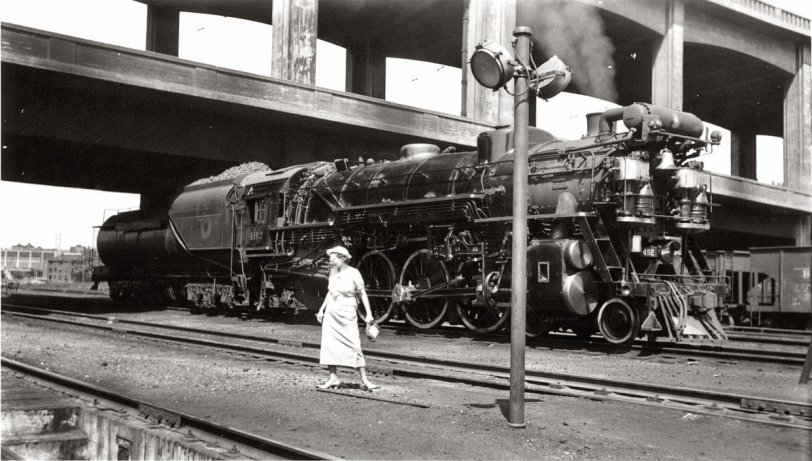


Framed or unframed, desk size to sofa size, printed by us in Arizona and Alabama since 2007. Explore now.
Shorpy is funded by you. Patreon contributors get an ad-free experience.
Learn more.

- Baldwin 62303
- Baldwin VO-1000
- Cold
- No expense spared
- Tough Guys
- Lost in Toyland
- And without gloves
- If I were a blindfolded time traveler
- Smoke Consumer Also Cooks
- Oh that stove!
- Possibly still there?
- What?!?
- $100 Reward
- Freeze Frame
- Texas Flyer wanted
- Just a Year Too Soon
- WWII -- Replacing men with women at the railroad crossing.
- Yes, Icing
- You kids drive me nuts!
- NOT An Easy Job
- I wonder
- Just add window boxes
- Icing Platform?
- Indiana Harbor Belt abides
- Freezing haze
- Corrections (for those who care)
- C&NW at Nelson
- Fallen Flags
- A dangerous job made worse
- Water Stop
Print Emporium
Where's the Ticket Window?

Most locomotive portrait artists were consummate professionals who didn't allow things like light poles--or old ladies--to obscure their subject. Whoever took this photo wasn't on his game apparently. The old lady--a rather comical figure, is she not?--is probably the photographers wife, but I like to think she's lost and wandering around the Cincinnati Union Terminal service area looking for the ticket window. The locomotive, for those who care, is C&O Pacific type #492. Photo dated July, 1937. View full size.
Cincy Union Terminal
Yes, that is the Cincy Union Terminal engine service facility. The Terminal and engine facility were completed in 1933. Unfortunately the service facility is now completely obliterated by the Queensgate yard built by then Chessie System in the 70's or 80's. The two decker bridge over the loco is known as Western Hills Viaduct and it did replace an earlier Harrison Street viaduct.
Loco Tender
The Vanderbilt rounded tender was a much more stronger structural design than the square box like tender and would hold more water or oil instead of coal due to its round shape. That's why tank cars and some hopper cars have a round shape on the sides, it also eliminated the required inside bracing needed for a box shape tender or freight car. Design was used for carrying liquids or grain or chemical powders.
C&O Pacific
This was almost certainly taken on the west side of Cincinnati near the large train yard. I wish I could see those buildings in the background a little better.
Pumps and Other Things
Yes, the flying pumps are the two sets of dual air compressors on the front of the boiler. Most locomotives had them mounted lower on the pilot or on the side of the boiler. The round water compartment on the tender wasn't the norm on most locomotives either. This was known as a Vanderbilt tender, and was designed to prevent water sloshing about when the engine was rounding a curve. Although all of the F-19's had one at one time or another, they were also swapped out with square tenders as needed, since tenders were relatively universal and interchangeable between locomotives of different types.
"I like those "flying pumps"
"I like those "flying pumps" on that Pacific"
Are you referring to the equipment on the front of the engine? Whatever they are, they sure look sexy. What a beautiful machine.
Is the cylindrical truck behind the coal tender standard equipment on these Pacifics? Water? That is a stunning looking engine!!
Location
Yes, I think the bridge is Harrison Avenue, and I have many more photos taken at this location of passenger locomotives from a number of railroads. CUT was an important passenger hub, used by Southern Railway, C&O, B&O, New York Central, Pennsylvania RR, Norfolk & Western, and Louisville & Nashville.
The flying pumps were common on C&O locomotives. The F-19, though far from the most powerful of its type, was certainly one of the most graceful.
Location
I like those "flying pumps" on that Pacific. Looks like either Western Ave or Harrison Ave Viaduct (one of them is gone but I cant remember which) and appears to look Southwest. If I remember correct the shops (adjacent to Storrs Yard) were near Ryerson Steel off Spring Grove Ave about a mile or so North of Cincinnati Union Terminal. CUT was relatively new when this photo was taken.
Locomotive Portrait
Hard to say who took the photo, as their were numerous locomotive portrait artists during that era. The goal of many of these men was the impossible task of still photographing every steam locomotive in America. No one ever came close of course, but since many of these photographers knew each other they often traded photos and negatives to add to their collections.
Photographer is unknown, but I'll take a stab and guess W.R. Osborne; he took many photos of C&O steam, both still and action, in the 1930's.
























On Shorpy:
Today’s Top 5